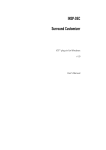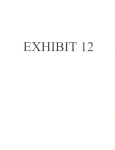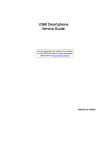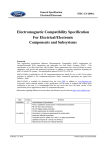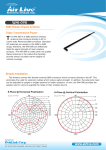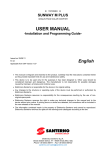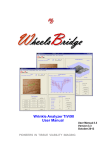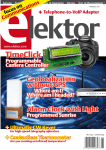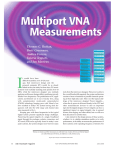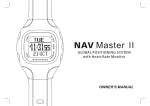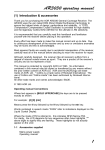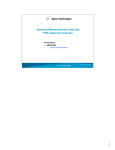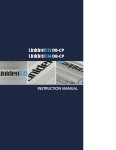Download USER MANUAL USER MANUAL FOR GENERAL ANTENNA
Transcript
USER MANUAL FOR GENERAL ANTENNAANTENNA-RELATED MEASUREMENTS AT THE NATR AT PAARDEFONTEIN Prepared by Dr. Dr. Dirk Baker for GEROTEK Report Gerotek 04/2010, Ver. 2.1 6 August 2010 LIST OF CONTENTS ABBREVIATIONS, PREFIXES AND SYMBOLS ............................................................................................... 1 CAUTION – ELECTROSTATIC DISCHARGE (ESD) ....................................................................................... 4 WARNINGS ................................................................................................................................................. 4 1. INTRODUCTION .................................................................................................................................. 5 2. VSWR AND INSERTION LOSS OF TEST CABLES.................................................................................. 6 Visual inspection ................................................................................................................................... 6 Adapters ................................................................................................................................................. 7 Measurement of test cables ............................................................................................................... 7 Torque ..................................................................................................................................................... 7 Repeatability ......................................................................................................................................... 8 Test cable historical data .................................................................................................................... 9 3. ANTENNA VSWR............................................................................................................................... 11 4. VEHICLE TURNTABLE......................................................................................................................... 13 5. POWER HANDLING .......................................................................................................................... 14 6. PHASE ............................................................................................................................................... 18 7. RADOMES ......................................................................................................................................... 21 8. SCALE MODEL MEASUREMENTS ...................................................................................................... 23 9. CONCLUSIONS ................................................................................................................................ 27 10. REFERENCES ..................................................................................................................................... 28 APPENDIX: GLOSSARY OF STANDARD ANTENNA TERMS ..................................................................... 29 Report Gerotek 04/2010, Ver. 2.1 6 August 2010 LIST OF TABLES Table 2.1 Recommended torque values for commonly used connectors ................................ 8 Table 8.1 Geometrical scaling of parameters................................................................................ 23 LIST OF FIGURES Figure 2.1 Test range instrumentation configured for antenna measurements, the antenna under test (AUT) is on the left and the source antenna is to the right ........................................................................................................................................ 10 Figure 5.1 Underground room below centre of concrete slab at the vehicle turntable ........ 16 Figure 5.2 Photograph of spectrum analyzer display using ‘maximum hold’ function to display signal activity in the 100 to 500 MHz frequency band for V and H polarizations ......................................................................................................................... 16 Figure 5.3 High power tests on 1 500 W CW, 30 to 100 MHz twin whip antenna ...................... 17 Figure 6.1 Photograph of full-scale test jig of upper fuselage section of Boeing 707 aircraft with hemispherical end caps to reduce edge diffraction ........................... 20 Figure 7.1 Test set up to evaluate radome transmission as a function of the angle of incidence ............................................................................................................................. 22 Figure 7.2 Test set up to evaluate impact of joints and fixing bolts in a radome test panel on antenna patterns .............................................................................................. 22 Figure 8.1 Scale model measurements on 1 : 25 scale model of Boeing 707 mounted on positioner of microwave range (Note the 2 to 18 GHz gain reference antenna on the PVC support).......................................................................................... 25 Figure 8.2 Measured yaw plane patterns (upper) and predicted patterns (lower) of 1 : 25 scale model of Boeing 707 ..................................................................................... 26 Report Gerotek 04/2010, Ver. 2.1 6 August 2010 1 ABBREVIATIONS, PREFIXES AND SYMBOLS A ampere A longitudinal amplitude taper AF antenna factor AR axial ratio Ae effective aperture Ap physical aperture AUT antenna under test BW beamwidth (half power unless stated) COMINT communications intelligence CP circularly polarized, circular polarization CW continuous wave D largest aperture dimension of AUT, m DC direct current DF direction finding, direction finder d diameter of source antenna, m dB decibel = 10 log (P2/P1) dBi decibels over isotropic dBci decibels over circularly polarized isotropic dBli decibels over linearly polarized isotropic ELINT electronic intelligence Ei incident electric field intensity, Vm-1 En normalized electric field intensity, Vm-1 Er reflected electric field intensity, Vm-1 F force, N f frequency, Hz G giga = 109 (prefix) G gain Gr gain of test antenna Gs gain of standard antenna Report Gerotek 04/2010, Ver. 2.1 6 August 2010 2 g gram gh partial gain for horizontal polarization gv partial gain for vertical polarization H horizontal H magnetic field, Am-1 HPBW half power beamwidth HF high frequency Hz hertz = 1 cycle per second hp height of positioner above ground, m hr height of centre of AUT above ground, m ht height of centre of transmit antenna above ground, m ᇱ h௧ apparent height of centre of transmit antenna above ground, m ICR integrated cancellation ratio k kilo = 103 (prefix) k ground reflection coefficient kg kilogram kW kilowatt L radar band, nominally 1 – 2 GHz L length of end-fire antenna, m LHCP left hand circularly polarized LPDA log-periodic dipole array M mega = 106 (prefix) m metre m milli = 10-3 (prefix) N newton Nm newton metre NATR National Antenna Test Range P polarization P power, W Pi power incident on antenna terminals, W Pr power reflected at antenna terminals, W R test range or test distance, m Report Gerotek 04/2010, Ver. 2.1 6 August 2010 3 RCS radar cross section RHCP right hand circularly polarized r radius, m rms root mean square RWR radar warning receiver S radar band, nominally 2 – 4 GHz SG standard gain SGA standard gain antenna SL sidelobe s second UHF ultra high frequency V vertical V volt VHF very high frequency VNA vector network analyzer VSWR voltage standing wave ratio Vi incident voltage, V Vr reflected voltage, received voltage, V W watt X radar band, nominally 8 – 12 GHz F (alpha) subtended angle of AUT at range R Fn (alpha) depression angle from source antenna to base of test tower Γ (gamma) voltage reflection coefficient Єap (epsilon) aperture efficiency λ (lambda) wavelength, m π (pi) = 3.1416… θhp (theta) half power beamwidth Report Gerotek 04/2010, Ver. 2.1 6 August 2010 4 CAUTION – ELECTROSTATIC DISCHARGE (ESD) ESD can damage the highly sensitive circuits in the VNA. ESD is most likely to occur as test devices are connected to or disconnected from the VNA test ports. The instrumentation can be protected by wearing a grounded static–discharge arm band. Alternately, the operator must ground himself by touching grounded metallic parts of the equipment (e.g. the outer chassis of the grounded VNA, the grounded test positioner, etc) before touching the VNA test ports or test cables connected to the VNA. Operators must avoid touching the centre conductors of test port connectors or test cables connected to the VNA unless they are properly grounded and have eliminated the possibility of static discharge. Ideally the centre conductors should not be touched if they are connected to the test equipment. Outdoor measurements using a sensitive vector network analyser (VNA) or other test receiver are particularly susceptible to static and/or lightning damage to the test equipment. Users must exercise all reasonable caution to eliminate damage to test equipment. Long coaxial cables can build up significant static charge on the outer jacket of the cable because of wind friction. Once the antenna or system to be tested is installed, the coaxial cables at the VNA/receiver end must be short-circuited to discharge the cable. It is good practice to install a 3 dB fixed attenuator at the output of the test cable. This reduces the dynamic range by 3 dB but the attenuator has a DC path to ground which provides continuous bleeding of charge build up to ground. This advantage far outweighs the loss of 3 dB of sensitivity. An additional safety precaution will be to add a DC block between the 3 dB attenuator and the test port. Custom high inductance circuits which provide a DC path to ground can also be used. The DC block and inductance circuits may have an effect on the sensitivity of the VNA and should be tested over the frequency ranges of interest before starting the measurement programme. WARNINGS 1. The user must ensure that the earth connections of his test equipment are in place and that there are no ‘floating earths’. Connect all equipment via a 3-pin grounded power outlet. If a grounded 3-pin outlet is not available, use a conversion adapter and connect the equipment ground terminal to ground. If mains power is supplied without grounding the equipment there is a risk of equipment damage and/or electrical shock to operators. 2. Do not exceed the rated input RF power levels of the VNA, particularly when power amplifiers are being used. The maximum rated power levels and DC voltages are normally stated on labels near the test ports. Typical values are + 27 dBm max and 40 VDC max. If there is uncertainty, consult the manufacturer’s operating manuals. Report Gerotek 04/2010, Ver. 2.1 6 August 2010 5 1. INTRODUCTION There are three main antenna test ranges at the NATR. These are the microwave range, the slant range and the VHF/UHF range. The operation of the ranges in terms of frequency coverage, size of antennas, gain patterns and measurement accuracy has been addressed in three separate user manuals [1] to [3]. In addition to these three test ranges there is a vehicle turntable which has an underground room below it. The vehicle turntable is not an automated positioner with an angular read out, but antenna patterns can be made in a manual mode. The site at the NATR is open and relatively clear of obstructions. Such a clear site is an asset to the NATR and as such can be used for antenna-related measurements which do not necessarily require the entire test range infrastructure. This user manual discusses a variety of antenna-related measurements which can be made at the NATR. These include: (a) VSWR and insertion loss of testcables (b) Antenna VSWR (c) Vehicle turntable (d) Power handling (e) Phase (f) Radomes (g) Scale model measurements There are other antenna-related measurements which are very specific to a particular user (e.g. antenna temperature). These are non-standard measurements and are usually done by a trained user with an approved test procedure. "Special-to-user" measurements are not discussed since they are not applicable to a general purpose antenna test facility. Although the NATR can be configured for outdoor radar cross section (RCS) measurements, there are no short-term requirements for RCS measurements. This was established during a survey for current and future use of the NATR [4]. Each of the topics listed above is discussed in turn in the following sections. Report Gerotek 04/2010, Ver. 2.1 6 August 2010 6 2. VSWR AND INSERTION LOSS OF TEST CABLES The NATR has a number of vector (i.e. able to measure both amplitude and phase) network analyzers (VNAs) which act as the test transmitters and receivers for the various ranges. The VNAs all have signal separating bridges which allow the measurement of S parameters (S11, S21, S12 and S22). VSWR (reflection coefficient) is measured as the S11 parameter and the insertion loss of a test cable as the forward transmission S21. Most of the antennas measured at the NATR are fed by 50 ohm coaxial transmission lines (coax lines). The S parameter bridges at the NATR are 50 ohm devices. The VNAs have 50 ohm calibration standards (open, short, load) which are required to calibrate the VNA to make accurate and repeatable measurements. A detailed description of the functional aspects of modern vector network analyzers is contained in Reference [5]. When using a VNA the operating manual for the specific equipment must be consulted. The manufacturer of the VNA specifies the measurement accuracy for the VNA under controlled conditions. All VNAs follow essentially the same calibration procedures. The operator attaches the calibration standards (open, short, load, through) to the S parameter test ports and the VNA calibrates itself over the selected frequency span. While the modern VNA is an extremely accurate RF measurement device, the final accuracy normally depends on the quality of the external connections to the VNA test ports. In a general purpose test facility such as the NATR the biggest causes of measurement errors relate to the condition of the test cables. Figure 2.1 shows a typical measurement set-up. The antenna under test (AUT) and a reference antenna are to the left and the source antenna is to the right. In this case the reference antenna is not a standard gain reference antenna as used for gain measurements but an antenna which picks up a sample of the incident signal in the test zone. This signal is used to phase lock the VNA to the signal generator at the remote source location. Amplitude and frequency drifts in the sweeping frequency synthesizer at the source antenna are compensated for in the reference channel. That is, if the source synthesizer drifts the test and phase lock reference drift together and S21 remains unaltered. There are two RF coaxial cables at the receive end connecting the AUT and the reference antenna to the receiver (VNA) – these are the critical cables. There is also a god quality cable connecting the signal source to the transmit antenna. There will be at least one additional coax cable at the source end if a power amplifier is used to increase the test field strength. Visual inspection All the coaxial cables must be tested over the frequency range of the measurements before final configuration of the test range as shown schematically in Figure 2.1. Each coaxial cable must be inspected for physical damage along its length and at the interface to the coaxial connectors. The attachment of the outer conductor of the coaxial cable to the outer conductor of the coaxial connector is generally the point at which the cable assembly fails as a result of repeated use. The connector interfaces on the coaxial cables must be inspected and be clean of contamination or dirt. Clean connectors are essential for reliable and repeatable RF measurements. Connectors can be cleaned using propanol on a cotton bud and gently removing any dirt. The connector must then be dried using clean compressed air or an aerosol dust spray. Ensure that no fibers from the cotton bud remain in the connector, particularly in the Report Gerotek 04/2010, Ver. 2.1 6 August 2010 7 spring fingers of the centre conductor. Connector and cable care are critical and short courses are available to ensure that users are aware of the pitfalls [6] and [7]. Visual inspection must include the position and offset of the centre conductors of all coaxial devices. There are suitable "pin depth gauges" for doing this on a wide range of connectors. Even if a pin depth gauge is not available, the location of the centre pins can be compared to existing devices which have pins which are captivated by the original manufacturer. This aspect is particularly important for long coaxial cables with type N (M) connectors. After repeated rolling out and subsequent rolling up of long cables, the cables can stretch – in some cases the male centre pin retracts inside the dielectric of the centre conductor making poor RF contact and in other cases the centre pin pushes too far forward. Here the shoulder of the male pin pushes up against the spring fingers of the female connector forcing them open. In severe cases this can lead to mechanical damage of the spring fingers which are made of beryllium copper which is very brittle. Adapters The test ports on the VNA are often APC7 or other precision measurement connectors. To interface the devices to be tested to the VNA, between series coaxial adapters are required to attach the test cables which may have N, SMA, 7/16, etc. connectors. These adapters should have good VSWR (less than 1.2 : 1) and they must be inspected and gauged for damage. At the AUT end adapters are again required. These may be coaxial between series adapters or adapters to the antenna input transmission line which could be a rectangular or double-ridged waveguide. All coax-to-waveguide adapters must be inspected for mechanical damage. On the microwave and slant ranges the standard gain reference horns have coax-to-waveguide adapters and the VSWR of these antennas must be measured on a regular basis to ensure that there has been no damage. Measurement of test cables The VNA should ideally be calibrated using a full two port calibration procedure using the procedures in the operations manual from the supplier. For some signal separating devices calibrations can be done for S11 and S21. These are adequate for measuring the coaxial cables to be used in the measurement set-up. After calibration, the measured reflection coefficient of the cable under test should usually be better than -20 dB up to 3 GHz when a matched load is attached to the far end of the cable. For general purpose cables operating to 18 GHz, the reflection coefficient increases to about -15 dB at 18 GHz. The insertion loss (S21) should be smooth without sudden increases or decreases in loss over very narrow frequency bands. These are referred to as insertion loss "spikes" and are generally as a result of cable damage or poor connector interfaces. Test cables having such spikes should not be used in measurements requiring a high level of repeatability. Torque All commonly used coaxial connectors have a torque specification (N m or lb ft) for tightening the male nut onto the female connector. All connections should be made using a torque wrench with the appropriate torque setting for the particular connector pair. When mating a male-female connector pair always rotate only the male nut. This ensures that the male centre pin slides into the female spring fingers without rotation. If the male pin rotates it can damage the spring fingers and it will lead to excessive wear of the plating on the pins. Connectors must Report Gerotek 04/2010, Ver. 2.1 6 August 2010 8 not be torqued to more than the specified torque because the connector pair can be damaged, particularly the centre pins. Torque specifications for commonly used connectors are provided by most connector suppliers. There are small discrepancies between suppliers but the torque values generally agree to 10%. Many suppliers (particularly American suppliers) specify torque in lb ft while European suppliers specify in terms N m or N cm. The conversion between these is given by 1 lb ft = 1.36 N m. When converting between lb ft and N m, suppliers will generally round the values up or down. Table 2.1 gives commonly accepted torque values for various connectors. Table 2.1 Recommended torque values for commonly used connectors Connector type Torque N cm (lb inch) Notes 136 (12) 1 3.5 mm, 2.92 mm, "K" 90 (8) 2 Precision 2.4 mm 90 (8) SMA (Brass) 56 (5) Precision 7 mm SMA (SS) 110 (10) 3 TNC 136 (12) 4 Type N 136 (12) 4 Type SC 160 (14) 7/16 Notes: 2 500 – 3 500 (225 – 315) 5 1. This connector is also called APC7. Finger tight is acceptable if connector has a knurled nut. 2. When connecting SMA to 3.5 mm use 90 (8). 3. SMA can also use 100 N cm. Note the lower torque for brass bodied (i.e. commercial grade) SMAs. 4. Finger tight is acceptable if knurled nut. 5. For 7/16 this is a very large torque, in part required to meet passive intermodulation specifications. Repeatability Repeatability refers to the correlation in the results between a number of measurements made repeatedly on the same device but by removing and reconnecting the RF cables between measurements. For example, the gain is measured by interchanging the test cable between the AUT and the standard gain antenna. The same gain value to a small change (say ± 0.1 dB) must be obtained for measurements made one after the other and on measurements made months apart. Some of the chief contributors to poor repeatability are the interconnecting coaxial cables. When the coaxial cables are being tested for VSWR and insertion loss, the stability of these parameters should be examined while flexing the cables (do not bend the cables to smaller than the specified minimum bend radius). The amplitude and phase of the insertion loss (S21) should be measured. General purpose commercial test cables are much more sensitive to flexing than high-performance test cables supplied with the VNA. Coaxial cables with braided or tape outer conductors are very sensitive to torsion (rotation about the axis of the cable). Under torsion the braid moves relative to the dielectric and severe phase shifts can occur. This phase problem (and accompanying amplitude changes) becomes worse with increasing Report Gerotek 04/2010, Ver. 2.1 6 August 2010 9 frequency. Cables which are acceptable to 3 GHz may be totally useless at 18 GHz. It must be stressed that the VNA uses both amplitude and phase data in the calibration procedure. Disturbance of the reference phase can lead to large measurement errors. The effects on amplitude and phase changes caused by cable flexing and torsion can be so severe that semi-rigid coaxial cables with solid outer conductors may have to be used to 18 GHz. Custom phase-stable cables may also be needed for long cable runs when the cables are exposed to differential heating (e.g. reference cable in the shade and test cable in the sun). Such phase-stable test set-ups require careful design and implementation and are not generally part of general purpose measurements. Relatively cheap RF to optical fibre transducers are available for operation to 3 GHz. RF to fibre cables to 18 and 40 GHz are available but are very expensive. The long-term stability of these devices in phase-stable measurement configurations will have to be evaluated. Test cable historical data All coaxial cables used in standard test and measurement set-ups at the NATR should be labeled and their VSWR (reflection coefficient, i.e. S11) and insertion loss (S21) measured and kept on file. These measurements should be repeated from time to time but at least once a year and the new data compared to the historical data. Any deviations should be noted and major deviations mean that the cables must be replaced. In a general-purpose facility where test cables are interchanged repeatedly between different measurement configurations, the test cables are almost consumable items with a limited useable life. Spare test cables should be available at the NATR so that measurement programs are not delayed by damaged cables. Note: Moisture ingress into cables and connectors can produce totally unpredictable and unexpected measurements. All joints in coaxial cables must be protected by waterproof tape or sealed in plastic wrap. Ultra low-loss coaxial cables have foam or tape dielectrics and once moisture has got inside the dielectric it is almost impossible to bake out. The outer jackets of these cables must be inspected routinely for mechanical damage, particularly small holes. Report Gerotek 04/2010, Ver. 2.1 6 August 2010 10 Figure 2.1 Test range instrumentation configured for antenna measurements, the antenna under test (AUT) is on the left and the source antenna is to the right Report Gerotek 04/2010, Ver. 2.1 6 August 2010 11 3. ANTENNA VSWR The antenna VSWR and the voltage reflection coefficient are related to the power Pi incident on the input terminals of the antenna and the power Pr reflected from the same terminals by Pr = Γ Pi 2 VSWR −1 = VSWR + 1 2 where Γ is the magnitude of the voltage reflection coefficient. The reflection coefficient in dB is 20 log Γ . The VNA measures the magnitude and phase of the reflection coefficient and this can be displayed in any of the common transmission line relationships (VSWR, Smith chart, real and imaginary, etc). For a transmitting antenna the VSWR is typically specified to be ≤ 1.5 : 1 (≤ -14 dB reflection coefficient). Receiving antennas can have much higher VSWR. Transmitting antennas must limit the amount of reverse power (reflected from the antenna input) to prevent damage to the transmitter or other components in the forward transmit chain. High power pulsed radars (100 kW to 1 MW) with waveguide inputs often have VSWR requirements of ≤ 1.1 : 1 (less than 26.4 dB reflection coefficient). Such very low VSWR values are difficult to measure and require custom waveguide test set-ups which can interface directly to the waveguide input to the radar antenna. Note that the VSWR is specified at the input terminals of the antenna. Ideally the antenna VSWR should be measured in its installed condition. This is often not possible and the "free-space" VSWR is measured. A high gain antenna must be placed such that its main beam does not point at any significant reflecting surface within at least 50 m from the antenna. If the reflecting surface is a building or a fence the beam should point at an oblique angle to the flat surfaces so that reflections scatter away from the antenna. The lower the antenna VSWR, the lower the interfering reflections must be. An omni-directional antenna must be mounted such that the omni-directional pattern does not look directly at the ground as happens when the omni-directional antenna is placed horizontal. That is, the antenna is mounted upright in its normal operating condition such that the omnidirectional pattern has no obstructions within the main beam of the elevation plane pattern. From the above discussion it is clear that there will be a significant length of coaxial cable to connect the AUT to the VNA. This must be a good quality cable in good condition as discussed in Section 2. The measurement must be made at the antenna terminals and thus the VNA calibration (open, short, load) must be done at the AUT end of the test cable. This process removes the cable loss and small stable ripples in the insertion loss from the measurements. Note that the cable must be stable in amplitude and phase so that there are no phase and amplitude changes between the calibration step and the connection to the AUT. If this is not the case the measurements will not be repeatable. If the test cable becomes too long, it may have significant loss and the reflection coefficient measurement may be "noisy". The VNA power must be increased, the IF bandwidth reduced and averaging increased to improve the dynamic range of the measurement. If the above Report Gerotek 04/2010, Ver. 2.1 6 August 2010 12 sensitivity improvements are not sufficient the VNA will have to be moved closer to the AUT and a shorter test cable employed. The requirement to limit extraneous reflections still applies. Note: When measuring VSWR all necessary static precautions must be taken. Some antennas have a DC open circuit at their input terminals (helical antennas, biconical dipoles, monopoles, discones, some LPDA antennas, etc). These open circuited antennas are particularly bad at allowing static build up and then the static can discharge via the input of the VNA or receiver. In many respects a biconical antenna with solid cones resembles a parallel plate capacitor. Report Gerotek 04/2010, Ver. 2.1 6 August 2010 13 4. VEHICLE TURNTABLE The vehicle turntable is at the centre of a 50 m diameter concrete slab at the N-E end of the VHF/UHF range. There is a "drive-on" platform for vehicles, helicopters, etc. and this platform can be rotated manually through a series of fixed angles (typically 5˚ to 10˚ intervals) in azimuth. At each set angle all the frequency data points can be measured in a single frequency sweep, at the next angular position all the frequencies are repeated, and so on. At the end of a single azimuth rotation there is a matrix of azimuth and frequency points. The azimuth patterns per frequency are then extracted from the matrix. The incident electric field at the centre of the vehicle turntable can be created with a broadband source antenna as described in [3] where the bilog CBL6143 which covers 30 – 3 000 MHz is used. Alternately a vertically polarized monopole can be used to launch a pure surface wave. Vertically polarized measurements are relatively easy. If horizontally polarized antennas are to be tested careful configuration of the range is required. As discussed in [3] the test zone is very near the ground and the measurements are made at a height where the net incident field is much lower than at the maximum which can be tens of meters above the test zone. A test range of between 50 and 100 m is adequate for the vehicle turntable. Many of the communications intelligence (COMINT) direction finding (DF) systems are calibrated and tested on the VHF/UHF range test positioner. These DF systems can be installed on vehicles and the DF performance in the presence of the vehicle evaluated on the vehicle turntable. Depending on the results, error correction tables can be implemented to improve the installed DF performance. The vehicle turntable can also be used to assess the installed DF performance of radar warning receiver (RWR) systems on, for example, a helicopter. Here the systems typically cover 2 to 18 GHz. A 600 mm diameter reflector antenna with a 1 to 18 GHz feed can be used as the source antenna. The principles of operating a ground reflection test range [1] can be applied to establish a suitable electric field for testing the RWR. Such measurements were made on a helicopter and DF errors made on a four channel RWR were shown to result from an incorrect installation. In this case the rearward facing antennas were set at 40˚ to the flight line and not set at the required 45˚. This was cause by an incorrect angle on the rear interface housings on the helicopter. Report Gerotek 04/2010, Ver. 2.1 6 August 2010 14 5. POWER HANDLING Many antennas (whips, monopoles, LPDAs, base station antennas, etc) have high power requirements. These antennas must comply with these requirements and be certified that they can handle the power. This is a user requirement to ensure that his equipment is not damaged by a failure of the antenna under high power conditions. Typical input powers are in the 600 W to 1 kW CW power range. Peak power (pulsed power) tests are normally done in situ on the installed radar system. Suitable safety precautions must be in place to ensure that people are not exposed to radiation hazard. This should be part of a test plan. Below the centre of the vehicle turntable there is an underground room with electrical power and air conditioning. This room is accessed via an underground walkway from the N – W side. The room is shown schematically in Figure 5.1 which shows a log periodic monopole array mounted on the concrete slab. High power tests can be done with all the test instrumentation (often customer furnished equipment) installed in the underground room. Careful planning is required for high power tests. The tests must not interfere with other users of the NATR and frequencies must be selected so that they do not fall in the commercial broadcast bands (VHF FM, TV), personal communications bands (GSM, Wi-Fi, etc) and civil aviation, police and military bands. The spectrum of all active frequencies occurring in the operating band of the AUT must be measured using a broadband monitoring antenna and a spectrum analyzer so that quiet frequencies can be identified and selected for the tests. The spectrum analyzer start/stop frequencies should be set to cover the entire frequency range over which power tests will be done. The resolution and video bandwidths should be set to achieve a noise floor below -90 dBm (set the internal attenuation to 0 dB). In order to capture activity on fluctuating signals the ‘maximum hold’ function of the spectrum analyzer is used. This captures signals in the environment even though they may occur only intermittently. To achieve -90 dBm of sensitivity, the spectrum analyzer sweep time is quite long (10 seconds or more). The spectrum analyzer should be left to measure the environment for about a half hour. The polarization of the monitoring antenna should match that of the antenna for which power tests are to be done. Figure 5.2 shows a photograph on the spectrum analyzer display from 100 to 500 MHz for V and h polarizations. It is clear that there is a lot of activity in this frequency band but there are also some relatively quiet parts of the band. CW power handling of antennas is the normally the least at the highest operating frequencies. So it is often only necessary to select one or two frequencies near the top of the operating frequency of the AUT. This may not be true for LPDAs which are subject to boom resonance phenomena. A boom resonance occurs when there are sudden changes in VSWR, gain and patterns which occur over very narrow frequency bands. The VSWR of the LPDA must be measured with a sufficient number of frequency points to identify the boom resonances. Power tests can then be done at these boom resonance frequencies provided they are not actively used by other operators. To reduce interference to terrestrial users the peak of the antenna pattern of the LPDA antenna is sometimes pointed vertically upwards so that the signal in the horizontal plane is at 90˚ from beam peak. The user must have high power couplers and a power meter to monitor the forward and reverse powers. The power amplifier must be able to deliver the required power to the coaxial cable feeding the antenna. The coaxial cable must be able to handle the power and its transmission loss must be known so that the power at the input to the cable can be increased to compensate for the cable loss. Report Gerotek 04/2010, Ver. 2.1 6 August 2010 15 Power tests are often conducted at night when sparking or arc-over can be observed from a safe distance using binoculars or an infrared camera. The personnel operating the test equipment are shielded by the mesh above the underground room. This greatly reduces the risk of radiation hazard to personnel. The tests proceed in a number of systematic steps. Power is applied at about 20% of the rated power for at least 20 minutes. During this time the forward and reverse powers are monitored. If no failure is observed, the power is turned off and the antenna is inspected. The power is then increased to 40%, and so on to 100% where the transmit power is again applied for 20 minutes. Depending on the customer requirement a final test could be done at some power higher than the rated power to provide a safety margin, say 120%. Increases in temperature are monitored using the infrared camera or thermocouples placed at the areas where failure is most likely to occur. Power tests at the NATR have been done primarily in the 20 to 1 000 MHz frequency range on communications antennas which cannot be tested indoors in anechoic chambers. For directional antennas operating in the microwave frequency region, high power absorbers can be used to attenuate the transmitted signal and reduce the risk of interference to other users of the frequency spectrum. Figure 5.3 shows a power test being conducted on a 1 500 W CW twin whip antenna for airborne applications. The twin whips are inclined as can be seen against the meter rule and the total height of the antenna is about 1.8 m. The protective and structural radome has been removed to expose the feed point at the centre of the antenna. Under this condition heating and arcing can be observed. Note that below the square 1.2 m x 1.2 m aluminium plate there is a 12 m x 12 m ground plane made of chicken mesh. The large ground plane is needed to obtain the required VSWR at the low-frequency end of the operating band of the antenna. Outdoor power tests of antennas must be carefully planned and monitored. Warning notice boards should be set up at access points to the NATR and specific test area to advise people at the NATR that RF power tests are being conducted. Care should be taken to ensure that personnel involved in the tests are not exposed to radiation hazard. In addition, there should be someone on duty at a safe distance from the tests to prevent persons not involved with the tests (e.g. maintenance staff, visitors to the NATR, etc.) entering the test area inadvertently. The spectral environment should be monitored from time to time with the spectrum analyzer during the execution of the tests to check that new users have not appeared during the tests. This may require alternate selection of test frequencies. Report Gerotek 04/2010, Ver. 2.1 6 August 2010 16 Figure 5.1 Underground room below centre of concrete slab at the vehicle turntable Figure 5.2 Photograph of spectrum analyzer display using ‘maximum hold’ function to display signal activity in the 100 to 500 MHz frequency band for V and H polarizations Report Gerotek 04/2010, Ver. 2.1 6 August 2010 17 Figure 5.3 High power tests on 1 500 W CW, 30 to 100 MHz twin whip antenna Report Gerotek 04/2010, Ver. 2.1 6 August 2010 18 6. PHASE The VNAs at the NATR can make accurate phase measurements provided there is enough signal power. The required signal levels to make phase measurements to a prescribed accuracy are given in the specifications of a particular VNA. The VNA makes phase measurements relative to some reference phase – whether this phase is the reference from the phase lock loop or from an external phase reference calibration. Phase measurements place particularly strenuous requirements on the phase stability of test cables. Changes in temperature can also have a significant impact on phase measurements. With changes in temperature, coaxial cables change their physical length. This gives a phase change which is a function of frequency with more phase change at the higher frequencies for the same temperature change. At 3 GHz, 1 mm of free-space path represents 3.6˚ of phase, at 18 GHz this 1 mm is 21.60˚ of phase. For solid PTFE dielectric cables this number must be multiplied by the square root of the dielectric constant or about 1.44 for PTFE. Manufacturers of coaxial cables normally specify a thermal coefficient for their cables. This coefficient is multiplied by the temperature change and the length of the cable to get the change in length and hence in the phase. These thermal effects can totally dominate phase measurements. In addition, flexure and torsion on a coax cable can result in significant phase changes (see discussion in Section 2 under "Repeatability"). When an antenna's phase properties are important, the phase is most often measured in a "before and after" adjustments and changes mode. This means that small adjustments to the antenna can be made provided its mounting position relative to the source is not changed. If the antenna moves a systematic error is caused by path length distance change from the source to the antenna. If the antenna is removed to make adjustments it should have dowels or other locating devices to ensure that the original mounting position is not changed. These relative phase measurements become more and more difficult as the frequency is increased. At 18 GHz backlash in the elevation axis (which moves the antenna slightly closer or further from the source) may be the dominant limitation to phase measurements. In these cases the elevation axis may have to be locked mechanically with a locking plate. Under this condition the power to the motor of the elevation axis must be switched off or disabled by the operator. The NATR is well suited to making phase tracking measurements between a set of antennas. Airborne high accuracy VHF DF systems often employ sets of phase tracking blade antennas configured in a phase interferometer array. These blade antennas typically cover 25 to 500 MHz and must track each other in phase to 8˚ or even 4˚ over all frequencies for sets of seven or more antennas. The manufacturer of the blade antennas normally has a "master phase reference" antenna. This is similar to a gain reference antenna whose gain values are accurately known; however, the phase reference must only have stable phase over time against which the phases of the other antennas are compared. For their proper functioning blade antennas need a ground plane. This ground plane should be large enough that diffractions from the edges do not put undesirable ripples in the phase responses. Alternately the ground plane can be a curved surface (like a cylinder) with hemispherical end caps to reduce diffractions. Such a test jig is shown in the photograph of Figure 6.1. The blades are mounted on the upper centre line of the ‘fuselage’, which in this case has the dimensions of the Boeing 707. The test jig is placed in an open area far from reflecting surfaces (e.g. at the vehicle turntable). One blade antenna is used as the transmit antenna which illuminates the ‘master phase reference blade’ and this phase reference is calibrated as a S21 through measurement against itself. This results in a reference trace against Report Gerotek 04/2010, Ver. 2.1 6 August 2010 19 which all the other blade antennas can be measured. This is similar to the "gain substitution method" for measuring antenna gain. Great care must be taken not to flex or twist the cables when interchanging blade antennas. It was found that to measure to an accuracy of ± 2˚ at 500 MHz it was necessary to use phase stable semi-rigid coaxial cables. These measurements use the VNA in a S21 mode and other than the open space of the site none of the other range infrastructure is used. The measurements are sensitive to interference from commercial and other transmitters and so the IF bandwidth of the VNA must be set to its minimum and some averaging and smoothing applied. Because the blades ore omnidirectional and vertically polarized, they receive signals from interfering transmitters (short wave, VHF FM, TV, etc). Even with the smallest IF band width and averaging, these transmitters may still put ‘noise’ on the phase data (recall the measurements require 2˚ accuracy and repeatability). In such a case it is sometimes beneficial to amplify the 10 mW transmit signal by 20 or 30 dB to 1 or 10 W CW. This will result in an ‘overdrive’ condition on the VNA where the received power now exceeds the safe limit of the VNA input port. Now one subtracts the equivalent of the gain (20 or 30 dB) from the receive line with a fixed 20 or 30 dB attenuator. This restores the test signal back to its original level. However the interfering transmission is reduced by 20 or 30 dB and the signal to interference level is improved by the same amount. This is often sufficient to improve the phase measurements to the required level. Report Gerotek 04/2010, Ver. 2.1 6 August 2010 20 Figure 6.1 Photograph of full-scale test jig of upper fuselage section of Boeing 707 aircraft with hemispherical end caps to reduce edge diffraction Report Gerotek 04/2010, Ver. 2.1 6 August 2010 21 7. RADOMES The effects of radomes on antenna gain and patterns can be made by conducting "without" and "with" radome comparative measurements. On the microwave range, structures up to 5 m in diameter can be measured. Care must be taken to compute the wind loading on large structures mounted on the test positioner [1]. Test samples of the dielectric materials used for radome manufacture can be evaluated by placing a receive antenna at a fixed position behind but close to the positioner and mounting the sample panel in front of the receiving antenna. The test panel can then be rotated to measure the transmission for vertical and horizontal incident polarizations as a function of the angle of incidence. This is shown schematically in Figure 7.1. The effects of joints and bolts can be evaluated as shown in Figure 7.2 which shows a 0.9 m diameter parabolic dish mounted directly behind a sample joint in a radome panel. Such measurements can assess the effects of joints and bolts before the final radome is manufactured. In recent years the effects of rain on GSM base station antennas has become a topic for discussion. It was observed that GSM signal quality was lost for a few minutes even after it had stopped raining. After some time the signal quality returned to normal. Examination of the radomes protecting the sector coverage panel antennas and the omni-directional antennas showed that antennas which had been installed for a few years had very different radome surfaces from new antennas. The new antennas had smooth surfaces and the rain ran off quickly forming droplets. The older antennas had surfaces which had been degraded by exposure to UV. The UV had attacked the resin in the fiberglass composite and exposed the fibers in the radome surface. These fibers hold the water and the water forms a continuous film over the radome surface rather than allowing droplets to run down. This water film has a high dielectric constant and this increases the reflection coefficient of the radome which increases the antenna VSWR. At the same time the incident field from the hand set reflects more from the water film and the received signal at the base transmitting station is reduced. Experiments were conducted where antennas which had varying degrees of UV damage were sprayed with water while measuring VSWR and monitoring the received signal. It was clear that new antennas shed water very quickly and recovered full operation. Antennas with superficial UV damage recovered in a minute or two but antennas with severe UV damage could take more than 10 minutes to recover. These tests cannot be conducted indoors because of water damage to absorbers in anechoic chambers. The outdoor test equipment at the NATR is unaffected by rain or water spray applied by hose pipe. With sufficient ingenuity a wide variety of radome measurements can be made at the NATR to support radome design and antenna evaluation. Report Gerotek 04/2010, Ver. 2.1 6 August 2010 22 Figure 7.1 Test set up to evaluate radome transmission as a function of the angle of incidence Figure 7.2 Test set up to evaluate impact of joints and fixing bolts in a radome test panel on antenna patterns Report Gerotek 04/2010, Ver. 2.1 6 August 2010 23 8. SCALE MODEL MEASUREMENTS When antennas are mounted on structures (ships, aircraft, vehicles, etc) the structures are so large and heavy that the structures cannot be mounted on any normal test positioner. The vehicle turntable of the NATR allows azimuth patterns of installed performance to be measured. These are effectively measurements on the horizon. When more detailed three-dimensional patterns are required measurements must either be made on the full-scale platform – which is very expensive – or scale models of the actual structure can be used. Scale models have the advantage that large structures can be accommodated on the test positioner of a conventional antenna range, there is complete control of the measurements and costs are reduced relative to operational measurements on full-scale platforms. The scale model measurements can be used to assess the accuracy of numerical modeling using powerful numerical analysis packages such as FEKO and CST which can be used to compute full 3-D patterns of antennas on aircraft and other structures. Geometrical scale modeling by a factor n, greater or smaller than unity, requires the scaling of all parameters as indicated in Table 8.1. The full-scale parameters are represented by the unprimed parameters and the primed parameters represent the scale model. Thus, is we reduce the size of the full-scale platform by a factor of 2, the frequency must double. The NATR has the capability to operate to 40 GHz so this will be the maximum scaled frequency and it sets the scale factor. It is difficult to build scale models (say 1 : 10) for a 18 GHz RWR system, because the scaled frequency becomes 180 GHz, which is impractical. Table 8.1 Geometrical scaling of parameters Scaled Parameters Unchanged Parameters Length l' = l/n Permittivity Time t' = t/n Permeability µ' = µ Velocity v' = v Impedance Z' = Z Wavelength Capacitance Inductance λ' = λ/n C' = C/n L' = L/n Echo area Ae' = Ae/n2 Frequency f' = nf Conductivity Antenna gain є' = є G0' = G0 σ' = nσ Scale modeling for antenna measurements requires that the scale models are physically and electrically identical to the full scale item. The actual full-sized antennas must be replaced by scale models of themselves. Blade antennas can be replaced by monopole antennas which make the modeling of blade antennas relatively simple. The unchanged parameters in Table 8.1 are valid provided the materials themselves are not frequency dependent. This is important for the selection of dielectric materials. The most difficult parameter to scale is the conductivity since it must increase by factor n. However, since many metals already have very good conductivity, the effect is not too large except for filters or cavity resonators. The geometrically scaled model can be used for pattern measurements, VSWR, gain and isolation between antennas on the platform. Isolation is an important parameter for EMI/EMC studies and scale models can greatly assist in these studies. Report Gerotek 04/2010, Ver. 2.1 6 August 2010 24 FEKO and CST require detailed mechanical drawings of the aircraft as well as parasolid files. The parasolid files can be imported directly into the numerical analysis software packages. This results in a great saving of time. The accuracy of the numerical modeling must be verified in some way. Good agreement between scale model measurements and numerical results gives confidence that the numerical modeling can be used for extensive parametric studies. Figure 8.1 shows a 1 : 25 scale model of a Boeing 707 aircraft mounted on a PVC pipe on the test positioner of the microwave range. About 1 m below the scale model there is a 2 to 18 GHz standard gain reference antenna so that all patterns can be measured in terms of absolute gain. The PVC pipe is covered with sheets of flat broad band radar absorbing material to reduce reflections. Note that the joints between the different surfaces of the aluminium model are taped closed using copper tape which has an electrically conductive adhesive. This eliminates the possibility of the joints reradiating as slot antennas. The installed antennas are blades covering the frequency range from 30 to 500 MHz. This means that the scaled frequencies are 750 MHz to 12.5 GHz. The 750 MHz to 2 GHz band is covered on the ground reflection range while the 2 to 12.5 GHz band is covered on the slant range using a 2 to 18 GHz dish as source. Figure 8.2 shows a comparison between the measured patterns of a top-mounted blade and those predicted by FEKO. These are yaw-plane patterns taken at 2.5 and 5 degrees below the horizon. Note that 12.4 GHz on the scale model is 496 MHz on the full-scale platform. The blade is at a forward position and so the yaw plane pattern is quite smooth over the forward sector. The vertical stabilizer is at 180˚ and its effects are clearly visible. The 5 to 10 dB ripples between about 135˚ to 150˚ and 210˚ and 225˚ are caused by the engine pods. The much smaller ripples about 1 dB in amplitude over the forward sector are also well reproduced. There is excellent agreement between measured and predicted patterns. The numerical model is suitable for conducting parametric studies where the blade antennas can be analyzed at many locations on the platform (e.g. for the placement design of a seven blade interferometer DF system). Scale modeling is a powerful measurement tool which can be used to support numerical electromagnetic analysis programs. The microwave and slant ranges are excellent facilities for making scale model measurements. Report Gerotek 04/2010, Ver. 2.1 6 August 2010 25 Figure 8.1 Scale model measurements on 1 : 25 scale model of Boeing 707 mounted on positioner of microwave range (Note the 2 to 18 GHz gain reference antenna on the PVC support) Report Gerotek 04/2010, Ver. 2.1 6 August 2010 26 Figure 8.2 Measured yaw plane patterns (upper) and predicted patterns (lower) of 1 : 25 scale model of Boeing 707 Report Gerotek 04/2010, Ver. 2.1 6 August 2010 27 9. CONCLUSIONS This user manual has highlighted the requirement for good connector care and the use of good quality test and interface cables. The VNAs are inherently extremely accurate and can make highly repeatable measurements. However, damaged or defective connectors and cables can significantly degrade the accuracy and repeatability of the measurements. Poor cable handling and incorrect torque settings for mating connector pairs are major contributors to measurement errors. The NATR can make excellent measurements of the VSWR of a wide variety of antennas. The vehicle turntable is an asset because it can make installed performance measurements of COMINT DF and RWR systems. The underground room below the vehicle turntable lends itself to the execution of power handling tests. The open site is ideal for making phase tracking tests on blade antennas installed on a mock-up of the platform. The microwave range and slant range are well-suited for making radome and scale model measurements. It is clear that the NATR is not only an antenna test range, but it is a site capable of making almost all antenna-related measurements. The wide frequency coverage from HF to 18 GHz and above and the other measurement capabilities make the site at Paardefontein a unique test facility. Report Gerotek 04/2010, Ver. 2.1 6 August 2010 28 10. REFERENCES 1. D.E. Baker, "User manual for the microwave range of the NATR at Paardefontein", Report Gerotek 01/2010, February 2010. 2. D.E. Baker, "User manual for the slant range of the NATR at Paardefontein", Report Gerotek 02/2010, February 2010. 3. D.E. Baker, "User manual for the VHF/UHF range of the NATR at Paardefontein", Report Gerotek 03/2010, February 2010. 4. D.E. Baker, "Future infrastructure requirements for the National Antenna Test Range (NATR) at Paardefontein", Ger_Report/01/09, January 2009. 5. M. Hiebel, "Fundamentals of Vector Network Analysis", Rhode & Schwarz, Munich, Germany, 3rd ed. 2008. 6. Agilent Technologies, "Cable and connector care", Course H7215B#160, Onsite training, www.agilent.com/find/education. 7. Agilent Technologies, "MEAS 102: Connectors and connector care", available at www.jsmyung.com/Library/ConnectorBasic.pdf. Report Gerotek 04/2010, Ver. 2.1 6 August 2010 29 APPENDIX: GLOSSARY OF STANDARD ANTENNA TERMS This glossary is an extract taken from the IEEE definitions and defines some of the most commonly used antenna terms (see IEEE Std. 149-1979, Definition of terms for Antennas for a complete listing). Consistent application of standard definitions will eliminate confusion relating to antenna specifications and interpretation of measured results. Antenna efficiency of an aperture-type antenna. For an antenna with a specified planar aperture, the ratio of the maximum effective area of the antenna to the aperture area. Aperture of an antenna. A surface, near or on an antenna, on which it is convenient to make assumptions regarding the field values for the purpose of computing fields at external points. Note: The aperture is often taken as that portion of a plane surface near the antenna, perpendicular to the direction of maximum radiation, through which the major part of the radiation passes. Aperture illumination. The field over the aperture as described by amplitude, phase and polarization distributions. Axial ratio (of a polarization ellipse). The ratio of the major to minor axes of a polarization ellipse. The ratio varies from infinity to 1 as the polarization changes from linear to circular. Beam. The major lobe of the radiation pattern. Bistatic cross section. The scattering cross section in any specified direction other than back toward the source. Cardinal plane. For an infinite planar array whose elements are arranged in a regular lattice, any plane of symmetry normal to the planar array and parallel to an edge of a lattice cell. Circularly polarized field vector. At a point in space, a field vector whose extremity describes a circle as a function of time. Note: Circular polarization may be viewed as a special case of elliptical polarization where the axial ratio has become equal to one. Copolarization. The polarization that the antenna is intended to radiate or receive. Cross polarization. In a specified plane containing the reference polarization ellipse, the polarization orthogonal to a specified reference polarization. Note: The reference polarization usually is the copolarization. Two fields have orthogonal polarizations if their polarization ellipses have the same axial ratio, major axes at right angles, and opposite senses of rotation. If the reference polarization is right-handed circular, the cross polarization is left-handed circular, and vice versa. Directivity (of an antenna) (in a given direction). The ratio of the radiation intensity in a given direction from the antenna to the radiation intensity averaged over all directions. Notes: (1) The average radiation intensity is equal to the total power radiated by the antenna divided by 4π. (2) If the direction is not specified, the direction of maximum radiation intensity is implied. Directivity, partial (of an antenna for a given polarization). In a given direction, that part of the radiation intensity corresponding to a given polarization divided by the total radiation intensity averaged over all directions. Report Gerotek 04/2010, Ver. 2.1 6 August 2010 30 Note: The (total) directivity of an antenna, in a specified direction, is the sum of the partial directivities for any two orthogonal polarizations. Effective area of an antenna (in a given direction). In a given direction, the ratio of the available power at the terminals of a receiving antenna to the power flux density of a plane wave incident on the antenna from that direction, the wave being polarization-matched to the antenna. Notes: (1) If the direction is not specified, the direction of maximum radiation intensity is implied. (2) The effective area of an antenna in a given direction is equal to the square of the operating wavelength times its gain in that direction divided by 4π. Elliptically polarized field vector. At a point in space, a field vector whose extremity describes an ellipse as a function of time. Note: Any single-frequency field vector is elliptically polarized if elliptical is understood in the wide sense as including circular and linear. Often, however, the expression is used in the strict sense meaning noncircular and nonlinear. E plane, principal. For a linearly polarized antenna, the plane containing the electric field vector and the direction of maximum radiation. Equivalent flat plate area of a scattering object. For a given scattering object, an area equal to the wavelength times the square root of the ratio of the monostatic cross section to 4π. Note: A perfectly reflecting plate parallel to the incident wavefront and having this area, if it is large compared to the wavelength, will have approximately the same monostatic cross section as the object. Far-field region. That region of the field of an antenna where the angular field distribution essentially is independent of the distance from a specified point in the antenna region. Note: In free space, if the antenna has a maximum overall dimension, D, which is large compared to the wavelength, the far-field region commonly is taken to exist at distances greater than 2D²/λ from the antenna, λ being the wavelength. The far-field patterns of certain antennas, such as multibeam reflector antennas, are sensitive to variations in phase over their apertures. For these antennas 2D²/λ may be inadequate. Fraunhofer region. The region in which the field of an antenna is focused. Note: In the Fraunhofer region of an antenna focused at infinity, the values of the fields, when calculated from knowledge of the source distribution of an antenna, are sufficiently accurate when the quadratic phase terms (and higher order terms) are neglected. Fresnel region. The region (or regions) adjacent to the region in which the field of antenna is focused (that is, just inside the Fraunhofer region). Note: In the Fresnel region in space, the values of the fields, when calculated from knowledge of the source distribution of an antenna, are insufficiently accurate unless the quadratic phase terms are taken into account, but are sufficiently accurate if the quadratic phase terms are included. Front-to-back ratio. For directional antennas, the ratio of the antenna’s effectiveness toward the front to its effectiveness toward the back (often expressed as a dB value). Gain, absolute (of an antenna) (in a given direction). The ratio of the radiation intensity, in a given direction, to the radiation intensity that would be obtained if the power accepted by the antenna were radiated isotropically. Notes: (I) Gain does not include losses arising from impedance and polarization mismatches. (2) The radiation intensity corresponding to the isotropically radiated power is equal to the Report Gerotek 04/2010, Ver. 2.1 6 August 2010 31 power accepted by the antenna divided by 4π. (3) If an antenna is without dissipative loss, then in any given direction, its gain is equal to its directivity. (4) If the direction is not specified, the direction of maximum radiation intensity is implied. (5) The term absolute gain is used in those instances where added emphasis is required to distinguish gain from relative gain; for example, absolute gain measurements. Gain, partial (of an antenna for a given polarization). In a given direction, that part of the radiation intensity corresponding to a given polarization divided by the radiation intensity that would be obtained if the power accepted by the antenna were radiated isotropically. Note: The (total) gain of an antenna, in a specified direction, is the sum of the partial gains for any two orthogonal polarizations. H plane, principal. For a linearly polarized antenna, the plane containing the magnetic field vector and the direction of maximum radiation. Intercardinal plane. Any plane that contains the intersection of two successive cardinal planes and is at an intermediate angular position. Note: In practice, the intercardinal planes are located by dividing the angle between successive cardinal planes into equal parts. Often, it is sufficient to bisect the angle so that there is only one intercardinal plane between successive cardinal planes. Isotropic radiator. A hypothetical, lossless antenna having equal radiation intensity in all directions. Note: An isotropic radiator represents a convenient reference for expressing the directive properties of actual antennas. Linearly polarized field vector. At a point in space, a field vector whose extremity describes a straight line segment as a function of time. Note: Linear polarization may be viewed as a special case of elliptical polarization, where the axial ratio has become infinite. Major lobe; main lobe. The radiation lobe containing the direction of maximum radiation. Note: In certain antennas, such as multi-lobed or split-beam antennas, there may be more than one major lobe. Mean sidelobe level. The average value of the relative power pattern of an antenna taken over a specified angular region, which excludes the main beam, the power pattern being relative to the peak of the main beam. Minor lobe. Any radiation lobe except a major lobe. See sidelobe. Monostatic cross section; backscattering cross section. The scattering cross section in the direction toward the source. Note: Compare this term with the term bistatic cross section. Near-field region. That part of space between the antenna and far-field region. Note: In lossless media, the near-field may be further subdivided into reactive and radiating near-field regions. Orthogonal polarization (with respect to a specified polarization). In a common plane of polarization, the polarization for which the inner product of the corresponding polarization vector and that of the specified polarization is equal to zero. Notes: (I) The two orthogonal polarizations can be represented as two diametrical points on the Poincare sphere. (2) Two elliptically polarized fields having the same plane of polarization have Report Gerotek 04/2010, Ver. 2.1 6 August 2010 32 orthogonal polarizations if their polarization ellipses have the same axial ratio, major axes at right angles, and opposite senses of polarization. Omnidirectional antenna. An antenna having an essentially non-directional pattern in azimuth and a directional pattern in elevation. The deviation from omni in the azimuth pattern is the difference between the maximum gain in the pattern (wherever it occurs in the pattern) and the minimum gain (wherever it occurs in the pattern) divided by two. This difference is expressed as a ± dB value. Phase center. The location of a point associated with an antenna such that, if it is taken as the center of a sphere whose radius extends into the far-field, the phase of a given field component over the surface of the radiation sphere is essentially constant, at least over that portion of the surface where the radiation is significant. Note: Some antennas do not have a unique phase center. Plane of polarization. A plane containing the polarization ellipse. Note: For a plane wave in an isotropic medium, the plane of polarization is taken to be normal to the direction of propagation. Polarization efficiency; polarization mismatch factor. The ratio of the power received by an antenna from a given plane wave of arbitrary polarization to the power that would be received by the same antenna from a plane wave of the same power flux density and direction of propagation, whose state of polarization has been adjusted for a maximum received power. Note: The polarization efficiency is equal to the magnitude of the inner product of the polarization vector describing the receiving polarization of the antenna and the polarization vector of the plane wave incident at the antenna. Polarization pattern (of an antenna). (1) The spatial distribution of the polarizations of a field vector excited by an antenna taken over its radiation sphere. (2) The response of a given antenna to a linearly polarized plane wave incident from a given direction and whose direction of a polarization is rotating about an axis parallel to its propagation vector; the response being plotted as a function of the angle that the direction of polarization makes with a given reference direction. Polarization, receiving (of an antenna). That polarization of a plane wave, incident from a given direction and having a given power flux density, which results in maximum available power at the antenna terminals. Polarization of a wave (radiated by an antenna in a specified direction). In a specified direction from an antenna and at a point in its far field, the polarization of the (locally) plane wave which is used to represent the radiated wave at that point. Principal half-power beamwidths. For a pattern whose major lobe has a half-power contour which is essentially elliptical, the half-power beamwidths in the two pattern cuts that contain the major and minor axes of the ellipse respectively. Radar cross section. For a given scattering object, upon which a plane wave is incident, that portion of the scattering cross section corresponding to a specified polarization component of the scattered wave. See scattering cross section. Radiation efficiency. The ratio of the total power radiated by an antenna to the net power accepted by the antenna from the connected transmitter. Radiation intensity. In a given direction, the power radiated from an antenna per unit solid angle. Report Gerotek 04/2010, Ver. 2.1 6 August 2010 33 Radiation pattern; antenna pattern. The spatial distribution of a quantity which characterizes the electromagnetic field generated by an antenna. Note: When the amplitude or relative amplitude of a specified component of the electric field vector is plotted graphically, it is called an amplitude pattern, field pattern, or voltage pattern. When the square of the amplitude or relative amplitude is plotted, it is called a power pattern. Radiation pattern cut. Any path on a surface over which a radiation pattern is obtained. Note: For far-field patterns the surface is that of the radiation sphere. For this case the path formed by the locus of points for which θ is a specified constant and \ is a variable is called a conical cut. The path formed by the locus of points for which \ is a specified constant and θ is a variable is called a great circle cut. The conical cut with θ equal to 90° is also a great circle cut. A spiral path which begins at the north pole (θ = 0°) and ends at the south pole (θ = 180°) is called a spiral cut. Radiation resistance. The ratio of the power radiated by an antenna to the square of the rms antenna current referred to a specified point. Note: The total power radiated is equal to the power accepted by the antenna minus the power dissipated in the antenna. Realized gain. The gain of an antenna reduced by the losses due to the mismatch of the antenna input impedance to a specified impedance. Note: The realized gain does not include losses due to polarization mismatch between two antennas in a complete system. Realized gain, partial (of an antenna for a given polarization). The partial gain of an antenna for a given polarization reduced by the loss due to the mismatch of the antenna input impedance to a specified impedance. Scattering cross section. For a scattering object and an incident plane wave of a given frequency, polarization, and direction, an area which, when multiplied by the power flux density of the incident wave, would yield sufficient power that could produce by isotropic radiation the same radiation intensity as that in a given direction from the scattering object. See monostatic cross section, bistatic cross section and radar cross section. Note: The scattering cross section is equal to 4π times the ratio of the radiation intensity of the scattered wave in a specified direction to the power flux density of the incident plane wave. Sense of polarization. For an elliptical or circularly polarized field vector, the sense of rotation of the extremity of the field vector when its origin is fixed. Note: When the plane of polarization is viewed from a specified side, if the extremity of the field vector rotates clockwise [counterclockwise], the sense is right-handed [left-handed]. For a plane wave, the plane of polarization shall be viewed looking in the direction of propagation. Shoulder lobe; vestigial lobe. A radiation lobe which has merged with the major lobe, thus causing the major lobe to have a distortion which is shoulder-like in appearance when displayed graphically. Sidelobe. A radiation lobe in any direction other than that of the major lobe. See mean side lobe level and minor lobe. Squint. A condition in which a specified axis of an antenna, such as the direction of maximum directivity or of a directional null, departs slightly from a specified reference axis. Notes: (1) Squint is often the undesired result of a defect in the antenna; but, in certain cases, squint is intentionally designed in order to satisfy an operational requirement. (2) The reference Report Gerotek 04/2010, Ver. 2.1 6 August 2010 34 axis is often taken to be the mechanically defined axis of the antenna; for example, the axis of a paraboloidal reflector. Standard [reference] directivity. The maximum directivity from a planar aperture of area A, or from a line source of length L, when excited with a uniform amplitude, equiphase distribution. State of polarization; polarization state (of a plane wave [field vector]). At a given point in space, the condition of the polarization of a plane wave [field vector] as described by the axial ratio, tilt angle, and sense of polarization. Tilt angle (of a polarization ellipse). When the plane of polarization is viewed from a specified side, the angle measured clockwise from a reference line to the major axis of the ellipse. Note: For a plane wave, the plane of polarization shall be viewed looking in the direction of propagation. Vestigial lobe. See shoulder lobe. Figure A.1 Pattern properties for antennas Report Gerotek 04/2010, Ver. 2.1 6 August 2010








































